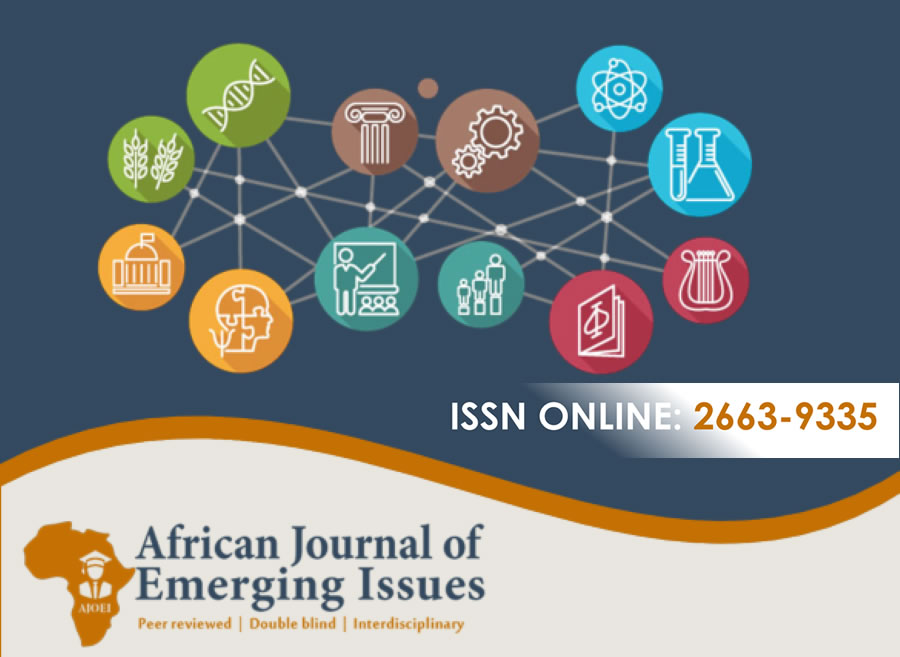CLIMATE CHANGE AND MAIZE PRODUCTION: A CASE OF KIAMBU COUNTY, KENYA
Abstract
Purpose of the Study: The overall objective of this study was to assess the impact of climate change on maize production in Kiambu County, Kenya.
Methodology: The study employed a mixed research methodology that combined qualitative as well as quantitative techniques, and production theory was applied to establish a theoretical framework. The study analyzed temperature and precipitation variations in Kiambu County in the period 2012 to 2020, and their subsequent impact on maize yields in the same period. Primary data was collected from 42 small-scale maize farmers in Juja, Gatundu North, Lari and Limuru sub-counties. Secondary data on precipitation and temperature levels in Kiambu County for the period 2012 to 2020 was sourced from the Weather and Climate global database. Secondary data on maize yields in Kiambu County from 2012 to 2020 was obtained from the Kenya National Bureau of Statistics.
Result: The study found that maize yields were influenced by both temperature and precipitation levels. However, only temperature was statistically significant in the model. Responses to the questionnaires distributed to forty-two small-scale maize farmers in Juja, Gatundu North, Lari and Limuru sub-counties indicated that the farmers have implemented a number of mitigation techniques, such as using more organic manure and fertilizers, spraying plants to ward off pests, watering manually when feasible, and planting trees in the surrounding areas. Some farmers, on the other hand, have adopted a more laid-back stance and did not implement any mitigation techniques since they felt they had no control over climate change.
Recommendation: The study recommends regular provision of capacity-building to small-scale maize farmers to increase awareness on climate change and possible mitigation techniques, equitable distribution of quality inputs such as seeds and fertilizers to the farmers, as well as enforcement of the law against destructive practices such as deforestation.
Keywords: Climate Change, Maize Production, Kiambu County, Kenya
References
Farm Link Kenya (2017). Maize production in Kenya.
Fosu-Mensah, B. Y., Manchadi, A., & Vlek, P. L. G. (2019). Impacts of climate change and climate variability on maize yield under rainfed conditions in the sub-humid zone of Ghana: A scenario analysis using APSIM. West African Journal of Applied Ecology, 27(1).
Guntukula, R., & Goyari, P. (2020). The impact of climate change on maize yields and its variability in Telangana, India: A panel approach study. International Journal of Science and Business, 17(1).
Kabara, M. A., Onono-Okelo, P. A., & Etyang, M. N. (2022). Vulnerability of smallholder maize production to climate variability in selected counties in Kenya. International Journal of Science and Business, 17(1).
Kabara, M. A., Onono-Okelo, P. A., & Etyang, M. N. (2023). Efficacy of adaptation of smallholder maize production to climate variability in selected counties of Kenya. International Journal of Science and Business.
Kariuki, G., Njaramba, J., & Ombuki, C. (2018). Climate change and maize yield in Kenya: An econometric analysis. European Scientific Journal, 19(1).
Kenya National Bureau of Statistics (2019). Kenya population and housing census: Population by county and sub-county, Volume 1. ISBN 9789966102096.
Kenya National Bureau of Statistics (2023). Maize production by county 2012 - 2020.
Kenya National Bureau of Statistics (2024). Economic survey 2024.
Milling Middle East and Africa (2024). Kenya’s maize output soars by 38.8% in 2023, aims to end imports by 2025.
Msowoya, K., Madani, K., Davtalab, R., Mirchi, A., & Lund, J. (2016). Climate change impacts on maize production in the Warm Heart of Africa. Water Resources Management, 30, 10.1007/s11269-016-1487-3.
Murray-Tortarolo, G., Jaramillo, V. J., & Larsen, J. (2018). Food security and climate change: The case of rainfed maize production in Mexico. Geocarto International. https://doi.org/10.1080/10106049.2019.1648564.
Siahi, W. V., Yego, H. K., & Bartilol, M. K. (2018). Effect of climate change on maize productivity in Kenya: A vector error correction model. IOSR Journal of Economics and Finance, 9(2), 28-33.
Soumaoro, T. (2021). Assessment of climate change impacts on maize production in Mali. World Journal of Agricultural Research.
United Nations Framework Convention on Climate Change (n.d.). What is climate change?.
Wandaka, L. M. (2016). The economic impact of climate change on maize production in Kenya. International Journal of Agricultural Research.
Wanyama, D. (2017). A spatial analysis of climate change effects on maize productivity in Kenya. Geocarto International. https://doi.org/10.1080/10106049.2019.1648564.
World Bank (2024). Kenya economic update: Transforming agricultural productivity to achieve food security for all.





